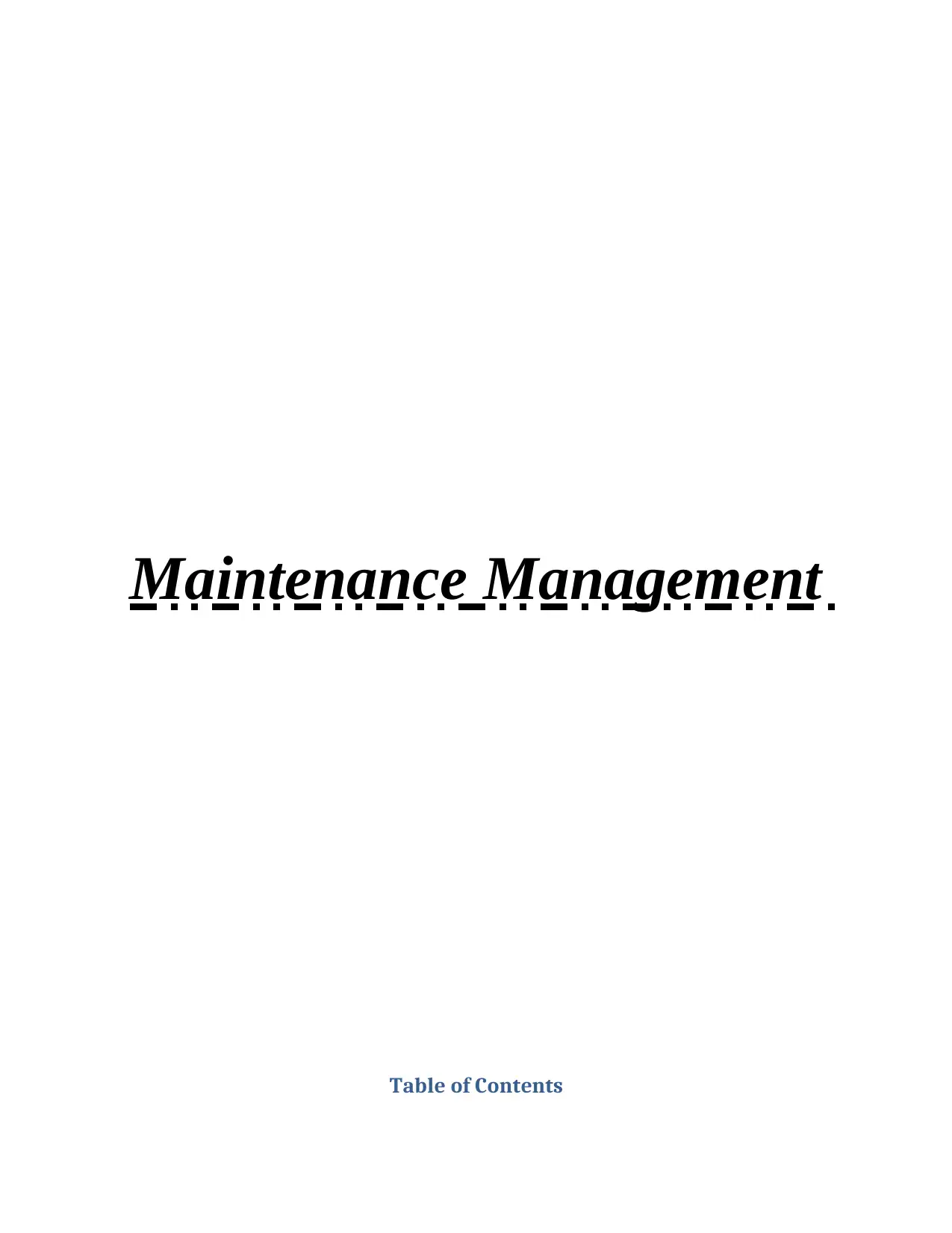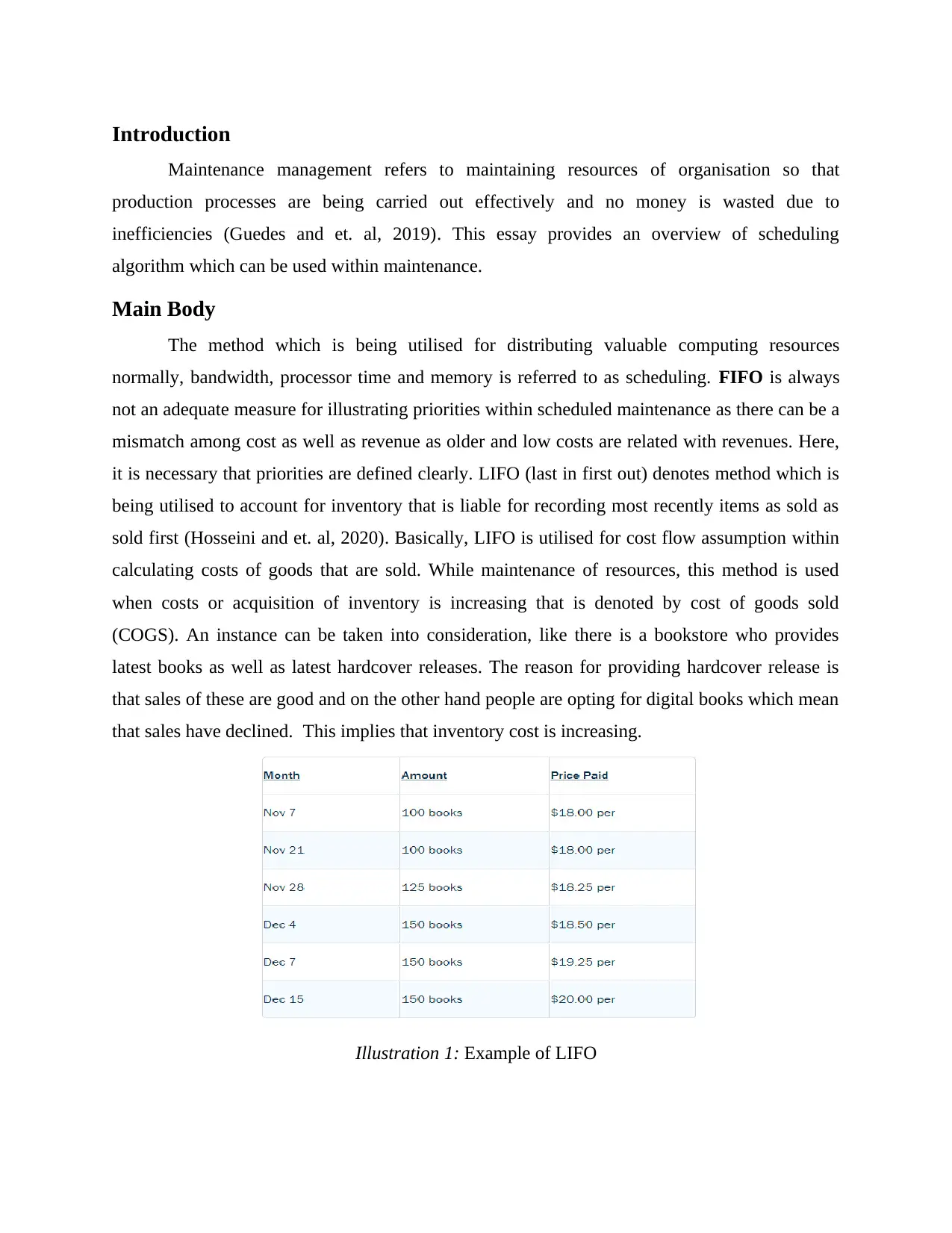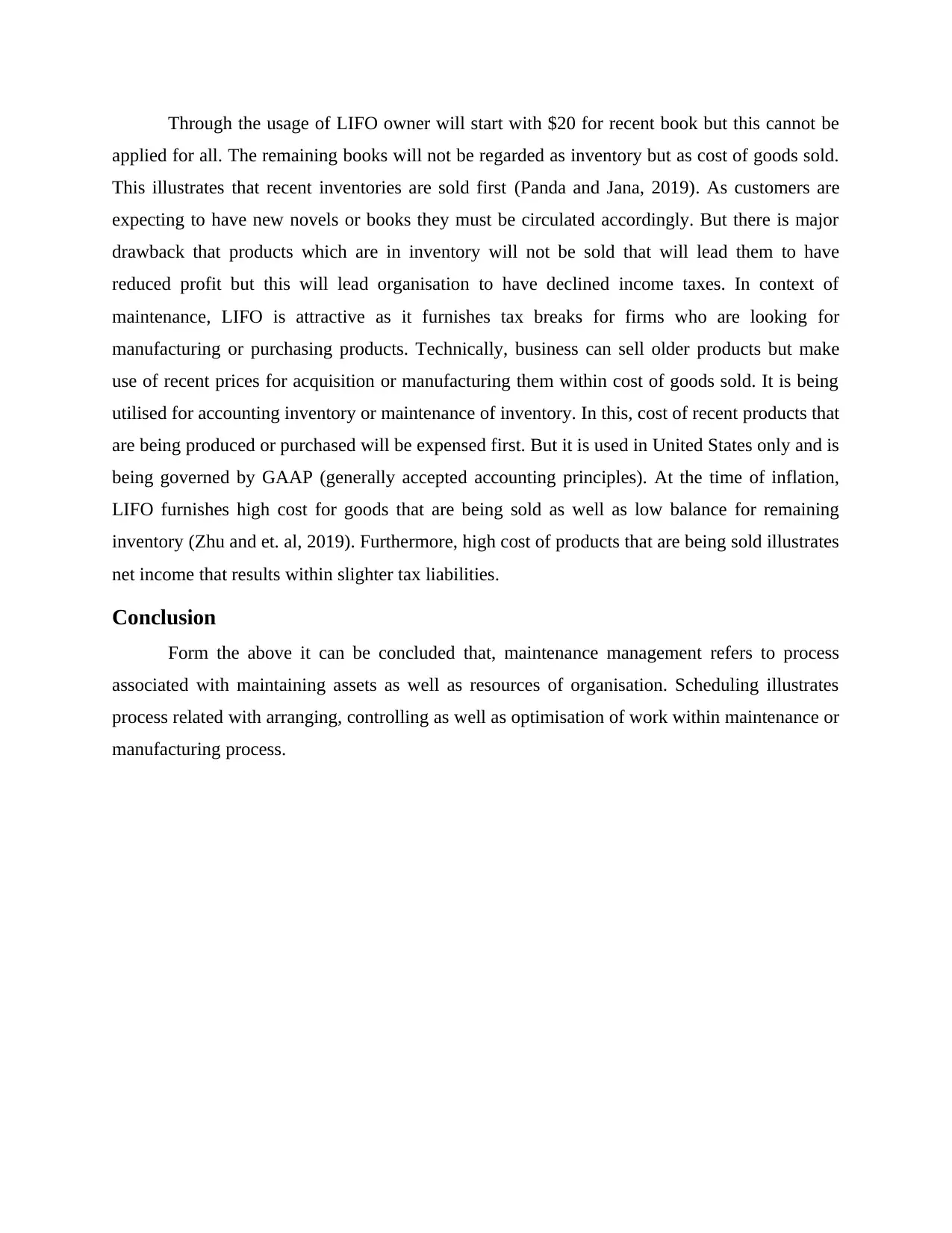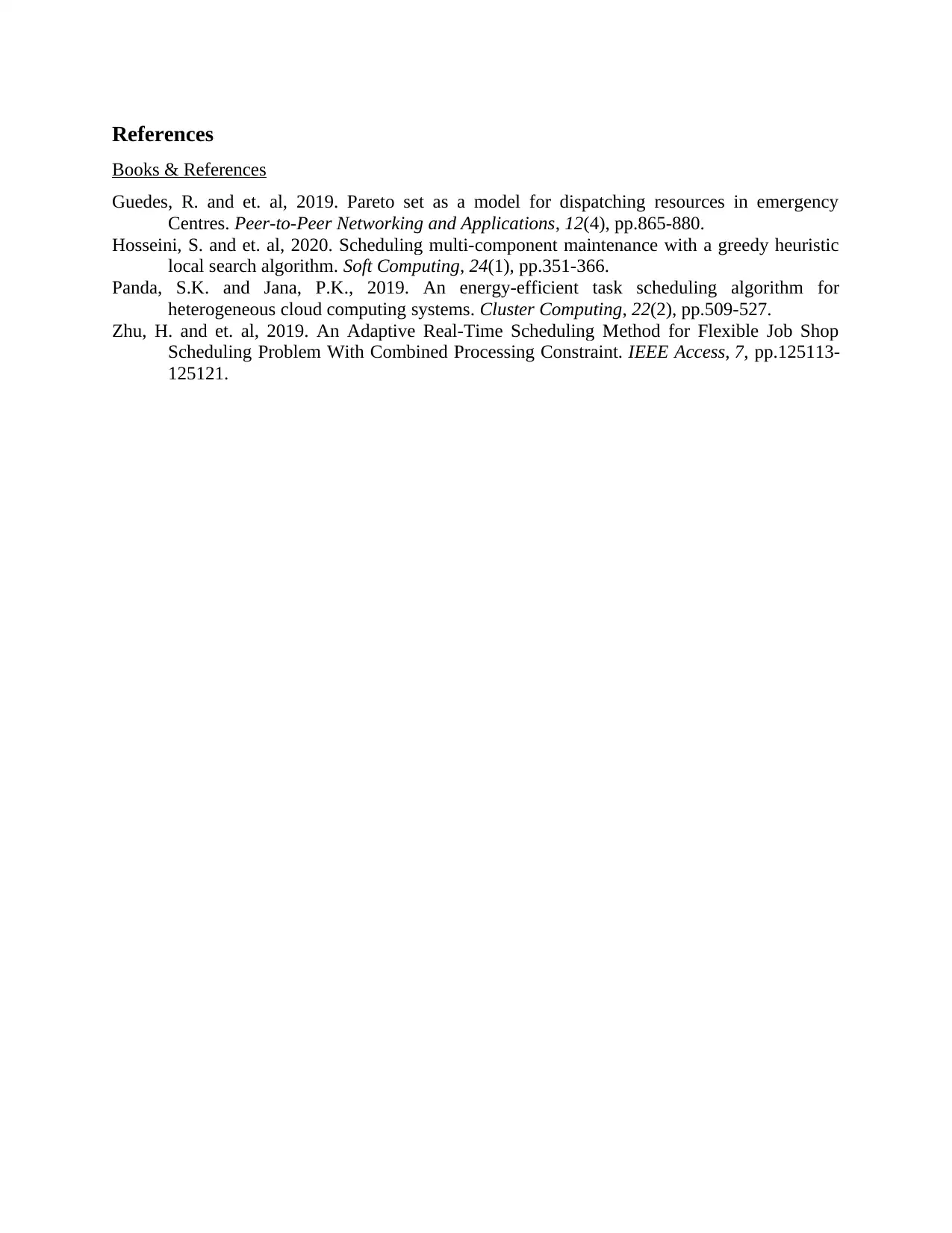Maintenance Management Report: LIFO Scheduling Algorithm Analysis
VerifiedAdded on 2023/01/11
|5
|736
|97
Report
AI Summary
This report provides an overview of maintenance management, focusing on scheduling algorithms. It explores the concepts of FIFO and LIFO methods, analyzing their application in resource allocation and cost management within an organization. The report delves into the importance of clearly ...

Maintenance Management
Table of Contents
Table of Contents
Paraphrase This Document
Need a fresh take? Get an instant paraphrase of this document with our AI Paraphraser

Introduction......................................................................................................................................3
Technology Plan..............................................................................................................................3
Conclusion.......................................................................................................................................3
References........................................................................................................................................4
Technology Plan..............................................................................................................................3
Conclusion.......................................................................................................................................3
References........................................................................................................................................4

Introduction
Maintenance management refers to maintaining resources of organisation so that
production processes are being carried out effectively and no money is wasted due to
inefficiencies (Guedes and et. al, 2019). This essay provides an overview of scheduling
algorithm which can be used within maintenance.
Main Body
The method which is being utilised for distributing valuable computing resources
normally, bandwidth, processor time and memory is referred to as scheduling. FIFO is always
not an adequate measure for illustrating priorities within scheduled maintenance as there can be a
mismatch among cost as well as revenue as older and low costs are related with revenues. Here,
it is necessary that priorities are defined clearly. LIFO (last in first out) denotes method which is
being utilised to account for inventory that is liable for recording most recently items as sold as
sold first (Hosseini and et. al, 2020). Basically, LIFO is utilised for cost flow assumption within
calculating costs of goods that are sold. While maintenance of resources, this method is used
when costs or acquisition of inventory is increasing that is denoted by cost of goods sold
(COGS). An instance can be taken into consideration, like there is a bookstore who provides
latest books as well as latest hardcover releases. The reason for providing hardcover release is
that sales of these are good and on the other hand people are opting for digital books which mean
that sales have declined. This implies that inventory cost is increasing.
Illustration 1: Example of LIFO
Maintenance management refers to maintaining resources of organisation so that
production processes are being carried out effectively and no money is wasted due to
inefficiencies (Guedes and et. al, 2019). This essay provides an overview of scheduling
algorithm which can be used within maintenance.
Main Body
The method which is being utilised for distributing valuable computing resources
normally, bandwidth, processor time and memory is referred to as scheduling. FIFO is always
not an adequate measure for illustrating priorities within scheduled maintenance as there can be a
mismatch among cost as well as revenue as older and low costs are related with revenues. Here,
it is necessary that priorities are defined clearly. LIFO (last in first out) denotes method which is
being utilised to account for inventory that is liable for recording most recently items as sold as
sold first (Hosseini and et. al, 2020). Basically, LIFO is utilised for cost flow assumption within
calculating costs of goods that are sold. While maintenance of resources, this method is used
when costs or acquisition of inventory is increasing that is denoted by cost of goods sold
(COGS). An instance can be taken into consideration, like there is a bookstore who provides
latest books as well as latest hardcover releases. The reason for providing hardcover release is
that sales of these are good and on the other hand people are opting for digital books which mean
that sales have declined. This implies that inventory cost is increasing.
Illustration 1: Example of LIFO
You're viewing a preview
Unlock full access by subscribing today!

Through the usage of LIFO owner will start with $20 for recent book but this cannot be
applied for all. The remaining books will not be regarded as inventory but as cost of goods sold.
This illustrates that recent inventories are sold first (Panda and Jana, 2019). As customers are
expecting to have new novels or books they must be circulated accordingly. But there is major
drawback that products which are in inventory will not be sold that will lead them to have
reduced profit but this will lead organisation to have declined income taxes. In context of
maintenance, LIFO is attractive as it furnishes tax breaks for firms who are looking for
manufacturing or purchasing products. Technically, business can sell older products but make
use of recent prices for acquisition or manufacturing them within cost of goods sold. It is being
utilised for accounting inventory or maintenance of inventory. In this, cost of recent products that
are being produced or purchased will be expensed first. But it is used in United States only and is
being governed by GAAP (generally accepted accounting principles). At the time of inflation,
LIFO furnishes high cost for goods that are being sold as well as low balance for remaining
inventory (Zhu and et. al, 2019). Furthermore, high cost of products that are being sold illustrates
net income that results within slighter tax liabilities.
Conclusion
Form the above it can be concluded that, maintenance management refers to process
associated with maintaining assets as well as resources of organisation. Scheduling illustrates
process related with arranging, controlling as well as optimisation of work within maintenance or
manufacturing process.
applied for all. The remaining books will not be regarded as inventory but as cost of goods sold.
This illustrates that recent inventories are sold first (Panda and Jana, 2019). As customers are
expecting to have new novels or books they must be circulated accordingly. But there is major
drawback that products which are in inventory will not be sold that will lead them to have
reduced profit but this will lead organisation to have declined income taxes. In context of
maintenance, LIFO is attractive as it furnishes tax breaks for firms who are looking for
manufacturing or purchasing products. Technically, business can sell older products but make
use of recent prices for acquisition or manufacturing them within cost of goods sold. It is being
utilised for accounting inventory or maintenance of inventory. In this, cost of recent products that
are being produced or purchased will be expensed first. But it is used in United States only and is
being governed by GAAP (generally accepted accounting principles). At the time of inflation,
LIFO furnishes high cost for goods that are being sold as well as low balance for remaining
inventory (Zhu and et. al, 2019). Furthermore, high cost of products that are being sold illustrates
net income that results within slighter tax liabilities.
Conclusion
Form the above it can be concluded that, maintenance management refers to process
associated with maintaining assets as well as resources of organisation. Scheduling illustrates
process related with arranging, controlling as well as optimisation of work within maintenance or
manufacturing process.
Paraphrase This Document
Need a fresh take? Get an instant paraphrase of this document with our AI Paraphraser

References
Books & References
Guedes, R. and et. al, 2019. Pareto set as a model for dispatching resources in emergency
Centres. Peer-to-Peer Networking and Applications, 12(4), pp.865-880.
Hosseini, S. and et. al, 2020. Scheduling multi-component maintenance with a greedy heuristic
local search algorithm. Soft Computing, 24(1), pp.351-366.
Panda, S.K. and Jana, P.K., 2019. An energy-efficient task scheduling algorithm for
heterogeneous cloud computing systems. Cluster Computing, 22(2), pp.509-527.
Zhu, H. and et. al, 2019. An Adaptive Real-Time Scheduling Method for Flexible Job Shop
Scheduling Problem With Combined Processing Constraint. IEEE Access, 7, pp.125113-
125121.
Books & References
Guedes, R. and et. al, 2019. Pareto set as a model for dispatching resources in emergency
Centres. Peer-to-Peer Networking and Applications, 12(4), pp.865-880.
Hosseini, S. and et. al, 2020. Scheduling multi-component maintenance with a greedy heuristic
local search algorithm. Soft Computing, 24(1), pp.351-366.
Panda, S.K. and Jana, P.K., 2019. An energy-efficient task scheduling algorithm for
heterogeneous cloud computing systems. Cluster Computing, 22(2), pp.509-527.
Zhu, H. and et. al, 2019. An Adaptive Real-Time Scheduling Method for Flexible Job Shop
Scheduling Problem With Combined Processing Constraint. IEEE Access, 7, pp.125113-
125121.
1 out of 5
Your All-in-One AI-Powered Toolkit for Academic Success.
+13062052269
info@desklib.com
Available 24*7 on WhatsApp / Email
![[object Object]](/_next/static/media/star-bottom.7253800d.svg)
Unlock your academic potential
© 2024 | Zucol Services PVT LTD | All rights reserved.